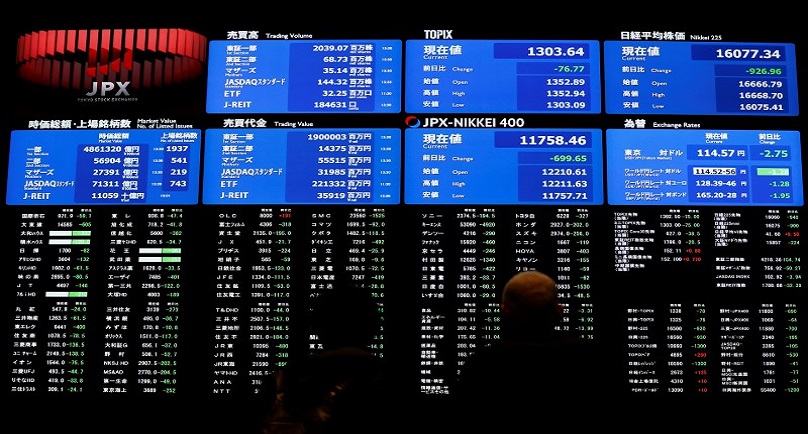Image: Visitors looks at an electronic board showing the Japan’s Nikkei average (top R) at the Tokyo Stock Exchange (TSE) in Tokyo, Japan, February 9, 2016. REUTERS/Issei Kato
By Wayne Cole
SYDNEY (Reuters) – Asian shares bounced on Monday, though investors feared fireworks as Chinese markets reopen after the long Lunar holidays to find there had been a major reversal in the U.S. dollar and a worldwide rout in equities.
Rallies in European bank stocks and on Wall Street on Friday helped soothe jitters enough for MSCI’s broadest index of Asia-Pacific shares outside Japan to rise 0.7 percent. That follows a loss of almost 4 percent last week.
E-Mini futures for the S&P 500 added 0.6 percent, while the cash market is closed for a holiday on Monday.
Japan’s Nikkei broke a vicious losing streak by jumping 4 percent. The bounce retraced only some of last week’s 11 percent drop, the largest such fall since 2008, and sentiment remained fragile.
“Although we consider the violent risk-off move of recent weeks largely unwarranted by economic fundamentals, the sheer magnitude of the sell-off has raised the risk that market volatility could feed back into the real economy,” said Ajay Rajadhyaksha, an economist at Barclays.
“Central banks have very limited ability to ride to the rescue of risk assets.”
Barclays pointed to three sources of volatility that had potential negative feedback loops: lower oil prices, capital outflows and macroeconomic weakness in China, and pressure on European banks.
“Of these, we consider China the biggest medium-term risk, but the least immediate issue,” wrote Rajadhyaksha.
Indeed, analysts assumed the People’s Bank of China (PBOC) would take the opportunity of the U.S. dollar’s recent decline to fix its yuan at a firm level on Monday, hoping to deflect speculation about a possible devaluation.
In an interview over the weekend, PBoC Governor Zhou Xiaochuan said there was no basis for the yuan to keep falling, and China would keep it’stable versus a basket of currencies while allowing greater volatility against the U.S. dollar.
Yet China also reports trade figures for January and any disappointment would be a setback to risk sentiment.
Median forecasts were for exports to dip 1.9 percent compared to a year earlier, with imports down 0.8 percent. The data tend to surprise, however, and estimates varied hugely from sharp falls to big rises.
Figures out over the weekend suggested there was still life in the Chinese consumer with retail sales growing 11.2 percent during the week-long Lunar New Year vacation compared with the same holiday period last year.
Retail figures from the United States out on Friday had also been relatively upbeat and helped calm market jitters a little.
The Dow ended Friday with a gain of 2 percent, while the S&P 500 added 1.95 percent and the Nasdaq 1.66 percent. The rally snapped a five-day losing streak, but all three indices were still down on the week.
Global oil prices had also surged as much as 12 percent on Friday after a report once again suggested OPEC might finally agree to cut production to reduce the world glut. [O/R]
Early Monday, U.S. crude had eased 29 cents to $29.15 a barrel, while Brent crude dipped 42 cents to $32.94.
Oil was aided in part by weakness in the U.S. dollar as a steep drop in Treasury yields undermined the currency’s interest rate differentials.
Against a basket of currencies, the dollar was up a shade at 96.171 having been at its lowest in almost four months. Likewise, it edged up to 113.64 yen, having touched a 15-month trough just under 111.00 last week.
The euro was last at $1.1217, having slipped from a 3-1/2 month peak of $1.1377.
Gold eased off to $1,231.60 an ounce, after enjoying its best week in four years.
(Reporting by Wayne Cole; Editing by Eric Meijer)
Copyright 2015 Thomson Reuters. Click for Restrictions.


